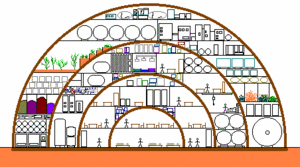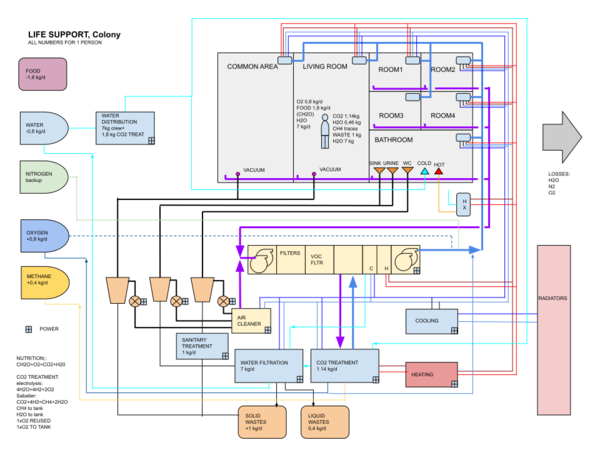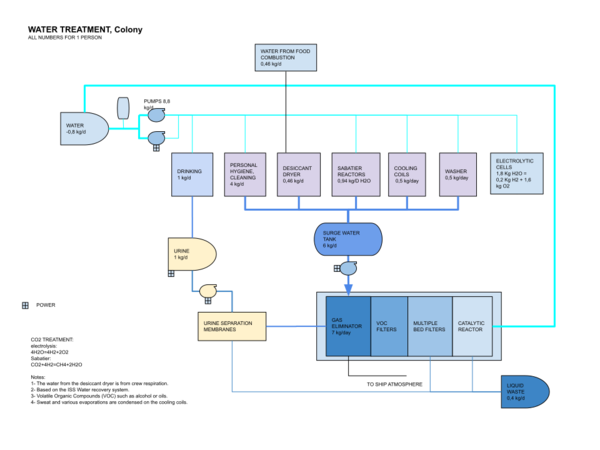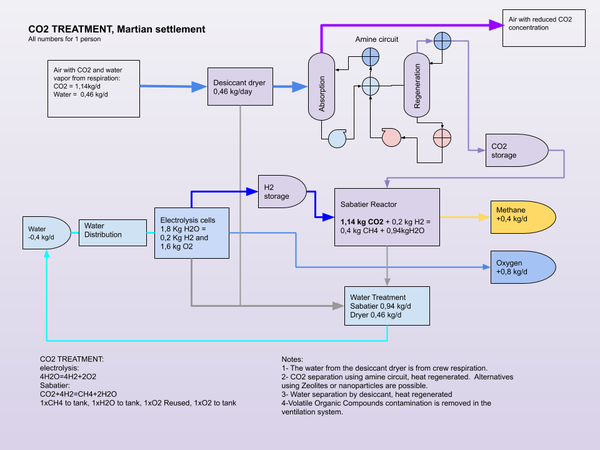Difference between revisions of "Life support"
| Line 62: | Line 62: | ||
Nitrogen is often seen as a relatively neutral buffer gas. However there is a nitrogen cycle in a natural life support system required for plant life. Nitrogen is relatively rare on MArs, so nitrogen losses should be kept to a minimum. | Nitrogen is often seen as a relatively neutral buffer gas. However there is a nitrogen cycle in a natural life support system required for plant life. Nitrogen is relatively rare on MArs, so nitrogen losses should be kept to a minimum. | ||
| − | |||
| − | |||
[[File:Colony life systems.svg|thumb|600x600px|Life support system per person]] | [[File:Colony life systems.svg|thumb|600x600px|Life support system per person]] | ||
| Line 72: | Line 70: | ||
The following is for a population of 1000 settlers. It can be generalized to smaller or larger populations. | The following is for a population of 1000 settlers. It can be generalized to smaller or larger populations. | ||
| − | === '''Potable water treatment''' === | + | ==='''Potable water treatment'''=== |
The system should be able to treat the water requirements for 1000 people. The theoretical minimum requirement is 3 l/day per person, or 3 m3 ( 3 tons) of fresh drinking water per day. Further allocations will be required for washing, sanitary usages, food production and other processes. | The system should be able to treat the water requirements for 1000 people. The theoretical minimum requirement is 3 l/day per person, or 3 m3 ( 3 tons) of fresh drinking water per day. Further allocations will be required for washing, sanitary usages, food production and other processes. | ||
| + | |||
| + | === '''Sanitary waste treatment''' === | ||
| + | The system should be able to treat/eliminate solid organic wastes, about 2 m3 per day. The system may be dry (compost) or wet (black water, i.e. sanitary piping and waste water treatment). | ||
| + | |||
| + | === '''Grey water treatment''' === | ||
| + | Water used for washing, showers and purposes other than human wastes must be recycled. | ||
| + | |||
| + | === '''Air recycling''' === | ||
| + | The air recycling system must be able to convert: 1 ton per day of CO2 into oxygen from human respiration, the CO2 (amount to be confirmed) from waste treatment. It must control humidity between 20 and 40%, limit temperature changes between 22 and 25 C and eliminate odors and volatile organic compounds. The air recycling system may also be used to transfer heat between different areas of the settlement. Water and refrigerant based heat transfer systems will be required to supplement the air recycling system. | ||
| + | |||
| + | If no air recycling is provided, the air replacement system must remove the CO2 and supply 770 kg of new oxygen per day, or a total of 280 tons of oxygen per year. A combined supply/recycle system may be acceptable for a very early settlement but needs to become autonomous rapidly. | ||
| + | |||
| + | === A'''ir and water loss''' === | ||
| + | The life support system shall be designed to handle air and water losses. The system should be able to replace up to 200 kg (200 m3) of air per day, and 100 kg of water per day (to be confirmed) as normal losses. For 1 year, this represents 72 tons of air and 36 tons of water. For 5 years, this signifies supplies of 360 tons of air and 180 tons of water. | ||
==Near-natural life support systems== | ==Near-natural life support systems== | ||
Revision as of 13:35, 12 May 2019
Live support systems are an essential and necessary part of a Martian settlement, since the natural Martian environment does not allow human beings to survive. More information on this topic is included in How living on Mars will be different than living on Earth.
Contents
Requirements
- Water is the most important requirement. No water no life.
- Oxygen must be combined with nitrogen to create breathing air inside the habitat.
- CO2 must be removed, ideally by plants.
- Food must be provided.
- The temperature inside the habitat must be comfortable.
- Waste must be treated and recycled.
NASA table of inputs to support a person in space (1977)
| Input | Per day | Per year | 1000 people |
| Dry food | 0,6 kg | 219 | 219 tons |
| Sanitary water | 2,3 kg | 840 | 840 tons |
| Water | 1,8 kg | 657 kg | 657 tons |
| Oxygen | 0,9 kg | 329 kg | 329 tons |
| Total | 5,6 kg | Example | Example |
The numbers are slightly different from other references. So we should provide for a certain margin of safety!
Water consumption, water cycle
Average water requirements are about 3 l/day for men and 2,2 l/day for women. For drinking purposes only. The water is not chemically changed in the body (unlike oxygen, for example) and can be recycled indefinitely. The human body actually creates extra water by combining oxygen with the hydrogen in carbohydrates, plus a bit of methane.
Food requirements
Humans require on average 2000 calories for women and 2500 calories for men, or about 2.2 kg of food per day. Food calories are in fact Kilo-calories; metric equivalents are 8,4 MJ per day for women and 10 MJ per day for men. This can be converted to an average power of 97W for women and 115 Watts for men. So on average, a human uses as much power as a 100W light bulb.
Oxygen consumption, oxygen/CO2 cycle
Humans breath about 11 000 liters of air per day of which 21%, or 2310 l is oxygen. Since we breathe out air at about 15% oxygen, 25% of the oxygen is consumed, or about 550 liters of oxygen per day. The density of oxygen is 1,4 g/l, or 1,4 kg/m3. So each crew member 'uses' 0,7 kg of oxygen per day. The oxygen is mostly used to burn hydrocarbons in cells, producing both water and CO2. The combustion of carbon creates CO2 according to the following equation: C + O2 = CO2 + 395 KJ/mole, or 9000 kJ/kg. 1000 people will consume 700 kg of oxygen per day and produce about 1 ton per day of CO2. 1000 people will breathe 11 000 m3 per day.
CO2 concentrations
CO2 concentrations are normally 400 PPM, or 0,04% of the atmosphere. Large variations are possible, but the maximum comfort zone is between 600 and 1000 ppm. Adverse health effect appear at 2500-5000 ppm. At 50 000 ppm and more severe symptoms occur and eventually death.
This sets the limits for the CO2 amount in the settlement atmosphere. For a 1000 person colony, colonists produce about 1 ton of CO2 per day. If there is no CO2 recycling, the concentration will go up fairly rapidly.
Nitrogen supply
Nitrogen is often seen as a relatively neutral buffer gas. However there is a nitrogen cycle in a natural life support system required for plant life. Nitrogen is relatively rare on MArs, so nitrogen losses should be kept to a minimum.
Artificial life support systems
The life support system on the ISS is optimized to low weight. It must be fuelled with large amounts of energy and it requires a constant replenishment with consumables.
The following is for a population of 1000 settlers. It can be generalized to smaller or larger populations.
Potable water treatment
The system should be able to treat the water requirements for 1000 people. The theoretical minimum requirement is 3 l/day per person, or 3 m3 ( 3 tons) of fresh drinking water per day. Further allocations will be required for washing, sanitary usages, food production and other processes.
Sanitary waste treatment
The system should be able to treat/eliminate solid organic wastes, about 2 m3 per day. The system may be dry (compost) or wet (black water, i.e. sanitary piping and waste water treatment).
Grey water treatment
Water used for washing, showers and purposes other than human wastes must be recycled.
Air recycling
The air recycling system must be able to convert: 1 ton per day of CO2 into oxygen from human respiration, the CO2 (amount to be confirmed) from waste treatment. It must control humidity between 20 and 40%, limit temperature changes between 22 and 25 C and eliminate odors and volatile organic compounds. The air recycling system may also be used to transfer heat between different areas of the settlement. Water and refrigerant based heat transfer systems will be required to supplement the air recycling system.
If no air recycling is provided, the air replacement system must remove the CO2 and supply 770 kg of new oxygen per day, or a total of 280 tons of oxygen per year. A combined supply/recycle system may be acceptable for a very early settlement but needs to become autonomous rapidly.
Air and water loss
The life support system shall be designed to handle air and water losses. The system should be able to replace up to 200 kg (200 m3) of air per day, and 100 kg of water per day (to be confirmed) as normal losses. For 1 year, this represents 72 tons of air and 36 tons of water. For 5 years, this signifies supplies of 360 tons of air and 180 tons of water.
Near-natural life support systems
On Mars we will not be able to maintain a life support system that needs consumables. The alternative is a near-natural carbon cycle with the growing of food and producing oxygen at the same time.
The challenge is the day and night rhythm as well as the lasting dust storms. Oxygen can only produced with light, either sunlight or artificial light. During the night or during a dust storm there may not be enough sunlight, either for direct lighting for the plants or for photovoltaic powered electric lights. The Biosphere 2 experiment has shown significant deviations from good oxygen conditions due to the day and night rhythm.
The first Martian settlement will probably be much smaller than Biosphere 2, making it even harder to keep a constant oxygen level. This article discusses solutions to mitigate this issue. The larger the settlement, the more stable it will be, as it will have more inertia.
Buffering the gases
Big tanks of water may be used to buffer some amount of oxygen as well as CO2, since those gases are soluble in water according to Henry's law. A good side effect is the heat capacity of the water, helping to keep a comfortable temperature in the settlement. Oxygen produced for propellant purposes will need to be stored, and this storage can be used to buffer the oxygen.
Constant artificial lighting
Parts of the oxygen producing greenhouses may be lit at night, which requires stored electrical energy. The stored energy must be large enough to cover a few months of dust storms, unless nuclear reactors are used. wind turbines may help to produce part of the needed energy.
Water
Water can be extracted from the atmosphere of from frozen deposits on the surface. Once it enters the life support system, water become part of the life process and ends up either in food, at the water treatment plant mixed up with waste, or in the atmosphere as a result of respiration. Water is also the source of propellant, so large amounts of water are required for the settlement. Water has very high specific heat, therefore it can hold a lot of heat. Water storage of energy is also a good source of stability and inertia in a settlement.
Respiration from humans and evapotranspiration from plants will load the atmosphere of a settlement with humidity. This water needs to be removed by condensation, or the humidity will become too high and the plants will no longer function, and the humans will be very uncomfortable. Desiccant systems with regeneration or cooling systems with condensation are two methods for dehumidifying the air in the settlement. The cold outside the colony can be used at a handy heat sink for dehumidification as well.
Energy requirements
Energy is required to run the life support system. The source of the energy is either the sun, though direct radiation of photoelectric systems, or nuclear fuel, using nuclear reactors. The energy required to run the life support system is considerably less than the energy required to produce propellant or to support industry.
The larger the life support system, the more stable it is.
Humans operate at about 100W of power. This comes from food, that eventually comes from photosynthesis. Photosynthesis has an efficiency of about 3-4%, but most of the production from photosynthesis is used by the plant itself. About 1% of the energy from photosynthesis turns into food, so the life support system of a settlement will require about 10 000W of solar power per inhabitant.
The other 99% is turned into plant and eventually biomass (about 1-2%), and into heat, in the form of evaporated water, known at latent heat, and a hot air, called sensible heat.











